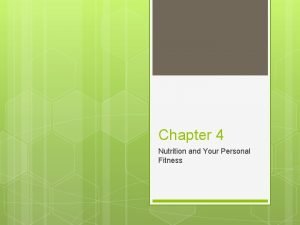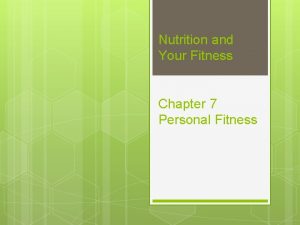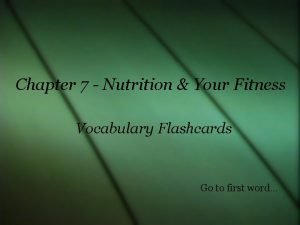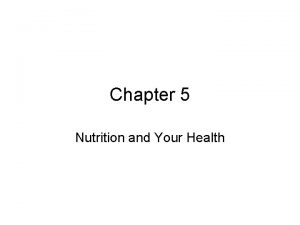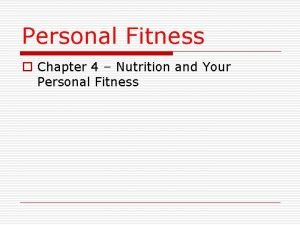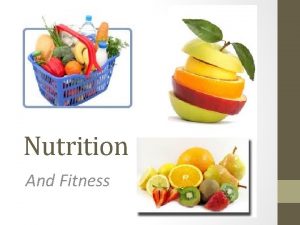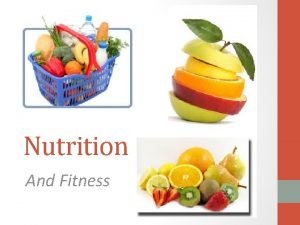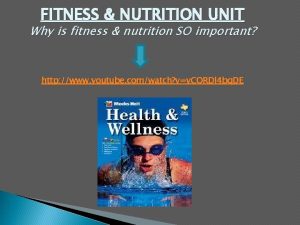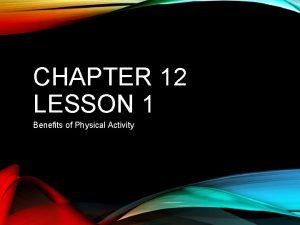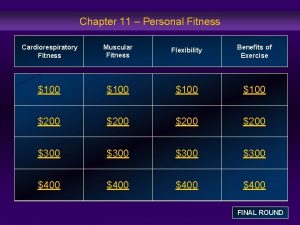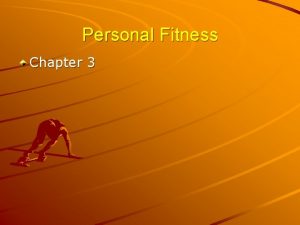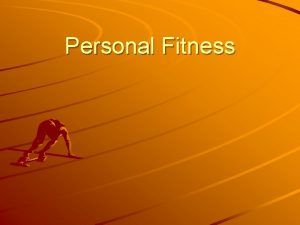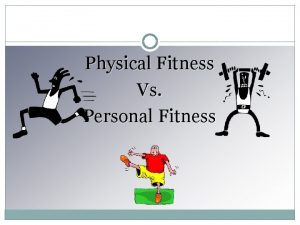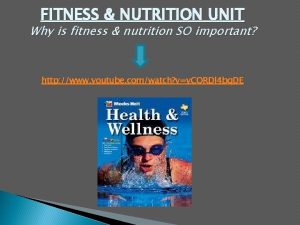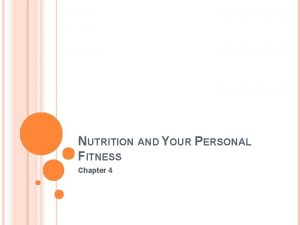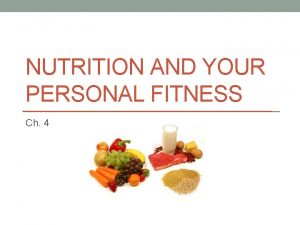Nutrition and Your Fitness Chapter 7 Personal Fitness
















- Slides: 16

Nutrition and Your Fitness Chapter 7 Personal Fitness

What is Nutrition is the process by which the body uses food for maintenance of life, growth, normal functioning of every organ and tissue, and the production of energy. Nutrients are chemicals or chemical compounds found in food that not only nourish the body, but also are necessary to life and good health.

What are the six groups of essential nutrients? Carbohydrates Protein Fats Minerals Vitamins Water

Food is the Foundation of Your Health and Fitness Food Fuel provides the following: or energy Stamina Basis and Vigor for sound, healthy skin, teeth, hair, muscles and bones

What is a Calorie The foods you eat contain calories, and a calorie is the common unit of measurement used to express potential energy Calories are byproducts of the chemical changes which your body produces from the food you eat

Calories Per Gram from Foods Fats – 9 Protein – 4 Carbohydrates -4

Guidelines for Good Nutrition Fats: 20 -35% trans fats and saturated fats less than 10% 40 -73 grams/day Proteins: 10 -35% 40 -60 grams/day Carbohydrates: 45 -65% 200 grams/day Mostly from complex carbs Only 10% from simple carbs

Carbohydrates Function: fiber Major source of energy; supplies Suggested Food Sources: Fruits, vegetables, grains, cereal Special Notes: Limit your intake of sugars! Ex. Table sugars, sweets, pastries, and soft drinks

Proteins Function: Important for growth and maintenance, along with the repair of body tissues Suggested Food Sources: Chicken, fish, meat, low -fat dairy products (milk, cheese), eggs, dried peas, beans Recommended Percentage in Diet: 10 -35%

Fats Function: Source of stored energy; provide and carry the fat-soluble vitamins (A, D, E, K) Food Sources: Monounsaturated fat: olive oil, canola oil, peanut oil Polyunsaturated fat: safflower oil, corn oil, liquid margarines Saturated fat: meat, butter, milk, solid shortenings Trans Fat: cookies, crackers, french fries, donuts, stick margarine Recommended Percentage in Diet: 20 -35% Special Note: Most people eat too much fat

Minerals Function: Important in activating numerous reactions within the body Suggested Food Sources: A variety of foods in the diet is necessary to supply the different minerals at the recommended levels Special Note: The balance between minerals is important. If you take too much of one mineral you may offset the functioning of another

Vitamins Function: Aid in absorbing and using the nutrients. Each vitamin helps one or more specific functions in the body. For example, vitamin B 1 Thiamin helps the nervous system; vitamin C helps cells and tissues; vitamin K helps with blood clotting. Suggested Food Sources: Vary with the specific vitamin. A variety of foods in the diet is necessary to supply the different vitamins at the recommended levels.

Water Function: Provides a medium within the cells in which the chemical reaction of the cells takes place; water also helps regulate body temperature, digest food, excretion, glandular secretion and the formation of blood plasma Suggested Food Sources: Beverages and liquids in foods Special Notes: It is important to drink more than just to satisfy thirst. Those involved in strenuous exercise programs must drink enough water to replace what is lost through perspiration. Drink water before, during, and after exercise

Cholesterol Is a waxy, fat-like material manufactured in the body and used by the body in many chemical processes. It is found in many foods of animal origin.

How many types of Cholesterol? 2 Types High Density Lipoprotein (HDL): considered to be the “good” cholesterol because it picks up the extra cholesterol and eliminates it from the body rather than allowing it to collect in the artery walls Low Density Lipoprotein (LDL): considered the “bad” cholesterol because it contributes to the clogging of the arteries by depositing the extra cholesterol on the lining of the arteries Lipoprotein: is a protein wrapped molecule which transports cholesterol and fats through the bloodstream

Glycemic Index A method of comparing foods based on how quickly the foods are digested into glucose and absorbed
 Chapter 4 nutrition and your personal fitness
Chapter 4 nutrition and your personal fitness Kelsey carbonetta
Kelsey carbonetta Fitness chapter 7
Fitness chapter 7 Seven nutrition and fitness
Seven nutrition and fitness Chapter 5 nutrition and your health
Chapter 5 nutrition and your health Chapter 1 why personal fitness
Chapter 1 why personal fitness Fitness & nutrition
Fitness & nutrition Fitness & nutrition
Fitness & nutrition Fitness & nutrition
Fitness & nutrition Fitness & nutrition
Fitness & nutrition Fitness & nutrition
Fitness & nutrition Fitness & nutrition
Fitness & nutrition Fitness & nutrition
Fitness & nutrition Health related skill
Health related skill Chapter 12 lesson 4 fitness safety and avoiding injuries
Chapter 12 lesson 4 fitness safety and avoiding injuries Chapter 12 physical activity and fitness
Chapter 12 physical activity and fitness Give us your hungry your tired your poor
Give us your hungry your tired your poor
